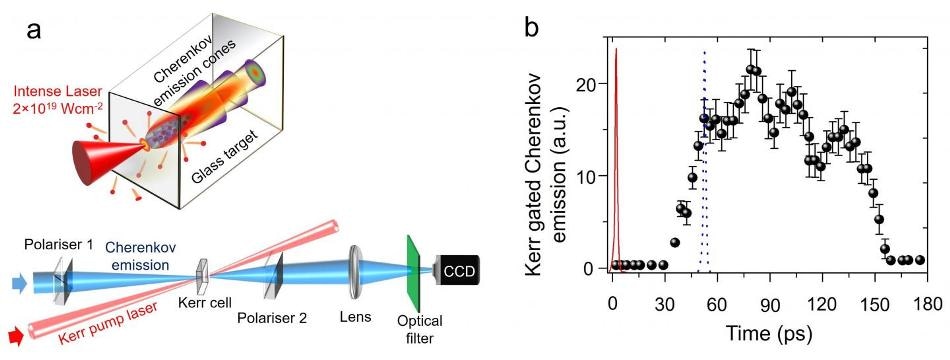Feb 8 2018
Living life in the fast lane can be extremely exciting, giving individuals the 'time of their lives' but how long does it really last? Experiments conducted at the Tata Institute of Fundamental Research (TIFR), Mumbai have answered this question for a bunch of electrons moving faster than light (fasten that the seatbelts!) via a piece of glass.
This study, performed in association with the Rutherford Appleton Laboratory in the UK and Centre for Intense Laser Studies and Applications (CELIA) in France has been featured in the Physical Review Letters on 5 February 2018.
 The table-top laser experiment at the Tata Institute of Fundamental Research, Mumbai. (a) A high power laser pulse creates mega-ampere electron current pulses. Cherenkov emission in the form of cones is emitted by these electrons traveling faster than light in glass. (b) the time trace of the Cherenkov emission measured in the experiment. (Image credit: Moniruzzaman Shaikh, P. P. Rajeev and G Ravindra Kumar)
The table-top laser experiment at the Tata Institute of Fundamental Research, Mumbai. (a) A high power laser pulse creates mega-ampere electron current pulses. Cherenkov emission in the form of cones is emitted by these electrons traveling faster than light in glass. (b) the time trace of the Cherenkov emission measured in the experiment. (Image credit: Moniruzzaman Shaikh, P. P. Rajeev and G Ravindra Kumar)
Why is this question significant? There are a number of reasons. First, these electrons drive giant current pulses (millions of ampere) that can produce some of the most exotic states of matter ever produced by man, imitating conditions discovered in stars and planet cores in a lab. However, that is not all. They are at the center of technologies generating improved electron, x-ray, and ion sources for applications in medicine and industry for one key reason - they can be produced on a small table top, unlike in standard methods involving huge accelerators.
These electron pulses are developed by a high power laser irradiating a glass target hosted in a vacuum chamber on a table top. The laser focused to a micrometer spot, produces such a monstrous intensity that it not only ejects the electrons in the glass immediately from their locations but also kicks them, almost instantaneously, to speed approaching that of light in free space. With the light pulse that drives these electrons being ultrashort (10's of femtoseconds in this case), these electron pulses are also very short. Light, however, is slowed down in glass and as a result, a number of these electrons result in traveling faster than light present inside that medium. Under these conditions, the electrons release a special type of radiation known as Cherenkov radiation. This radiation thus provides a measure of the number of 'faster than light' electrons and their "lifetime" in the medium.
This radiation can last for how long? The challenge in measuring this refers to the fact that the timescale of this emission is below the lowest that can be measured with normal electronic circuits, which is usually a few billionth of a second. The team thus produces a 'light-induced ultrafast shutter' lasting two-trillionths of a second, which is triggered by the same laser. With this ultrafast shutter, they are capable of measuring the temporal evolution of the Cherenkov signal (and thus the lifetime of these super-luminal electrons) with a 1000 x enhanced temporal resolution. They succeeded in discovering the surprising result that the fast electrons live much longer within a solid - much longer than the time they should theoretically take in order to traverse the target, lasting more than 2000 times longer than the exciting laser pulse. Modeling carried out by scientists at CELIA throws light on some of this unusual behavior.
How is this finding useful? For one, the knowledge of the lifetime of these fast electrons enables unraveling their transport process in solids, which is vital for a number of areas of high energy density science ranging from laser-driven fusion to developing improved radiation sources for medical and industrial applications.
Life in the fast lane can also be useful besides just being exciting.